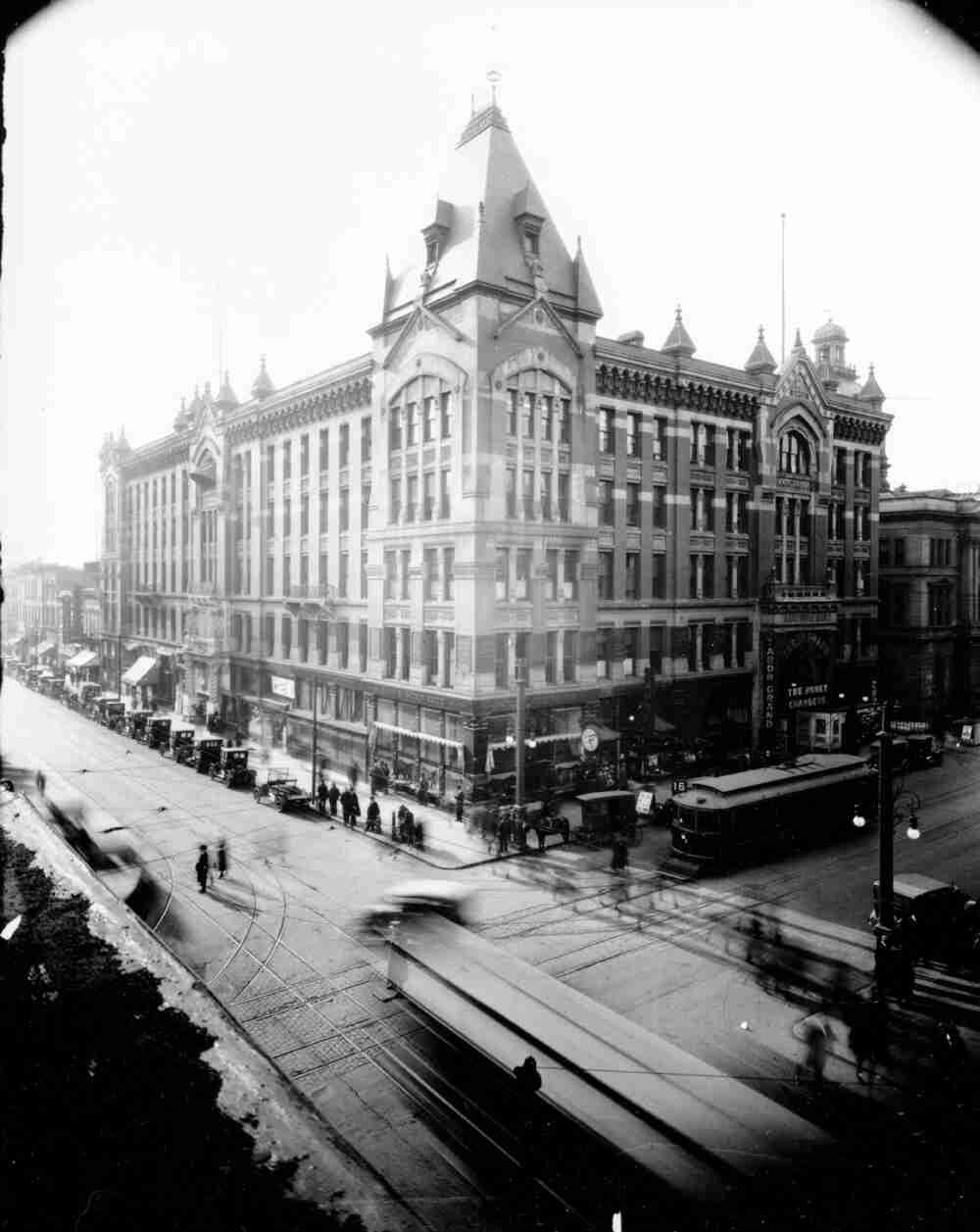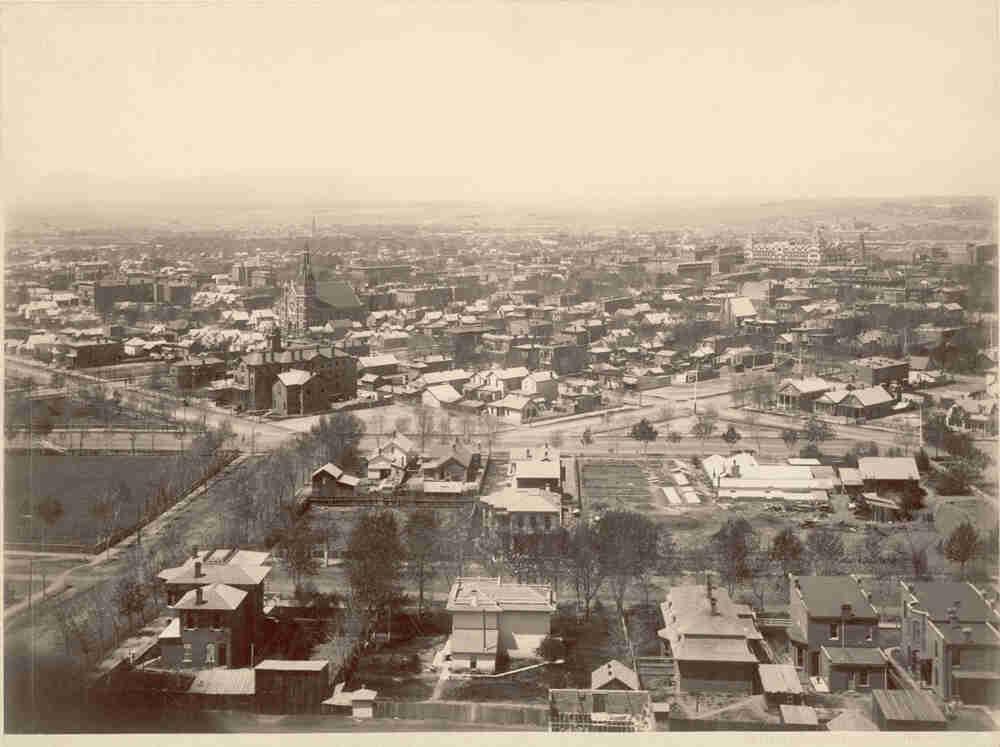Tabor Grand Opera House
Full Article
The Tabor Grand Opera House, constructed by the state’s famed Tabor family, was one of the city’s primary cultural institutions during the late 1800s. The Grand Opera enjoyed a period of popularity and success before falling by the wayside, a story that paralleled the fate of the Tabor family. Today, the Grand Opera serves as an example of the region’s cultural development and the fickle nature of success in the boom-and-bust American West during the late nineteenth century.
Opera in Colorado
Denver’s location 500 miles east or west of the nearest population centers and double that to San Francisco meant that most entertainment troupes bypassed the city. After the Civil War a fledgling theatrical circuit made its way along the stagecoach routes from Omaha and Kansas City to San Francisco via Cheyenne, Denver, Salt Lake City, Virginia City, and Sacramento. This sort of transportation, however, was too slow and costly for most theatrical companies, especially for the opera troupes that enjoyed less popular appeal than circuses, stage plays, and song-and-dance acts. In 1870 two rail lines finished construction in Denver—one westward from Kansas City and the other a spur from the transcontinental Union Pacific mainline in Cheyenne—facilitating access to the city. Yet major opera companies still avoided Denver. Too many playing dates could be lost reaching the city and leaving it, and the town lacked a properly equipped theater with enough seating to make opera financially attractive to entrepreneurs.
As a result, Denver’s early exposure to grand opera was piecemeal and of varying quality. Singers “Mr. and Mrs. Gruenwald,” employed at Thomas Maguire’s Opera House in San Francisco, provided Denver with its first operatic experience of record on December 8 and 9, 1864. En route to New York City, the Gruenwalds found themselves stranded in Denver when heavy snows on the high plains blocked all roads east. Shortly, two evenings of entertainment were scheduled at the Denver Theatre, a sizable two-story wood structure at the northeast corner of G (Sixteenth) and Lawrence Streets.
Enter the Tabors
Silver magnate Horace A.W. Tabor had already built Leadville a $65,000 opera house that opened in November 1879. Now, motivated by a characteristic blend of self-promotion and philanthropy, Tabor announced in March 1880 that he had purchased land at Sixteenth and Curtis Streets, where he would build Denver, the thriving “Queen City of the Plains,” the opera house it deserved. Tabor and his architect, W. J. Edbrooke, went to inspect other opera facilities to gather ideas. Construction began that summer. Tabor proclaimed that no expense would be spared in bringing to Denver the finest opera house in the American West. Accordingly, Edbrooke imported cherrywood from Japan, mahogany from Honduras, and paintings from Europe to adorn the interior. A single order from Marshall Field in Chicago, consisting of silk plush chairs, tapestry, and carpeting, amounted to $15,714. Estimates of the total cost of the multi-story opera house block ranged from $750,000 to $850,000, an extravagant sum at the time.
Tabor wanted the opening of his opera house to be the grandest cultural and social event in the history of Colorado, and determined that the theater should be dedicated with a two-week season, beginning on September 6, 1881. He selected America’s most popular prima donna, Emma Abbott, and her Grand English Opera Company to do the honors, offering her a lavish guarantee of $20,000, plus $3,070 for railroad fare. Tabor’s choice of Abbott was appropriate for other reasons: the two of them had much in common as both were native-born, ambitious, and rose from modest beginnings to prominence. Tabor’s decision to have an opera season in English may have stemmed from his strongly held beliefs about egalitarianism and accessibility, notions that enjoyed wide acceptance throughout the American West.
Grand Opening
On opening night Denver inaugurated one of the most magnificent opera houses in North America, opening with William Vincent Wallace’s Maritana sung by the beguiling and energetic Abbott and her troupe. Despite a chilly drizzle, a capacity crowd of 1,500 filled the Tabor Grand Opera House. Though Abbott had chosen Maritana as the dedicatory entertainment, she could not resist beginning the evening by singing the Mad Scene from Lucia di Lammermoor, a decision that she announced to the Rocky Mountain News the previous day.
Newspaper accounts of the grand opening were ecstatic. Save for some uncertainty in the orchestra, the performance gave complete satisfaction. Headlines from the Rocky Mountain News blared: “Perfection! Tabor’s Great Triumph Opened Last Night. The Grandest Mile Stone in Denver’s Career Fitly Dedicated by America’s Favorite.” The remainder of the inaugural season was a huge success. Abbott followed Maritana with a performance of Lucia, again garnering favorable reviews. Though the Rocky Mountain News admitted that other sopranos had sung the title role better, it deemed Abbott’s singing satisfactory and lauded her histrionic ability. Over the next two weeks, the Abbott organization mounted eight additional full-length productions, a remarkable achievement for any touring company, especially so early in the season.
The farewell performance of Saturday evening, September 17, billed as a benefit for Abbott, featured excerpts from Romeo and Juliet, Faust, Cecelia’s Love, and Paul and Virginia. Except for Cecelia’s Love, that had to be postponed a week to allow for rehearsal, the troupe delivered everything it had promised on schedule, which experienced patrons certainly appreciated. Abbott sang every night, with the exception of September 8 and 14, when she allowed Julia Rosewald to sing the soprano roles in Il trovatore and The Bohemian Girl. Aside from occasional remarks about intonation problems in the orchestra, criticism of Denver’s 1881 opera season remained mild.
Between 1881 and 1890, the Tabor hosted a number of operatic luminaries. Christine Nilsson and Amalia Materna gave concerts there in 1882 and 1885, respectively. In 1884 James Henry Mapleson brought his opera troupe, including Adelina Patti and Etelka Gerster. But when he returned in 1886, Mapleson’s company appeared at the Academy of Music rather than at the Tabor Grand.
Waning Success
The grandness of the Tabor Grand lasted only nine years. In August 1890 the Broadway Theatre, “uptown” on Broadway near Sixteenth Street, opened with a two-week inaugural season given by the Emma Juch Grand English Opera Company. Thereafter, most of the leading attractions came to the Broadway rather than the Tabor. Abbott, who returned to Denver at least six times, remained the city’s most popular prima donna until her death in 1891, just before her company was scheduled to give yet another season of opera in the city. As for Horace Tabor, financial declines during the Panic of 1893 left him bankrupt, and he was forced to sell his opera house in 1896. It became a decrepit third-run movie house and was torn down in 1964.
Virtually destitute, Tabor was charitably appointed postmaster of Denver in 1898 and died the following year. The verse that Tabor chose to adorn his grand opera house’s fancy decorated curtain was prophetic:
So fleet the works of men,
Back to the earth again;
Ancient and holy things
Fade like a dream.
Adapted from Harlan Jennings, “‘The Singers Are Not on Speaking Terms’: The Grand Opera in Denver: 1864–1881,” Colorado Heritage Magazine 19, no. 2 (1999).





